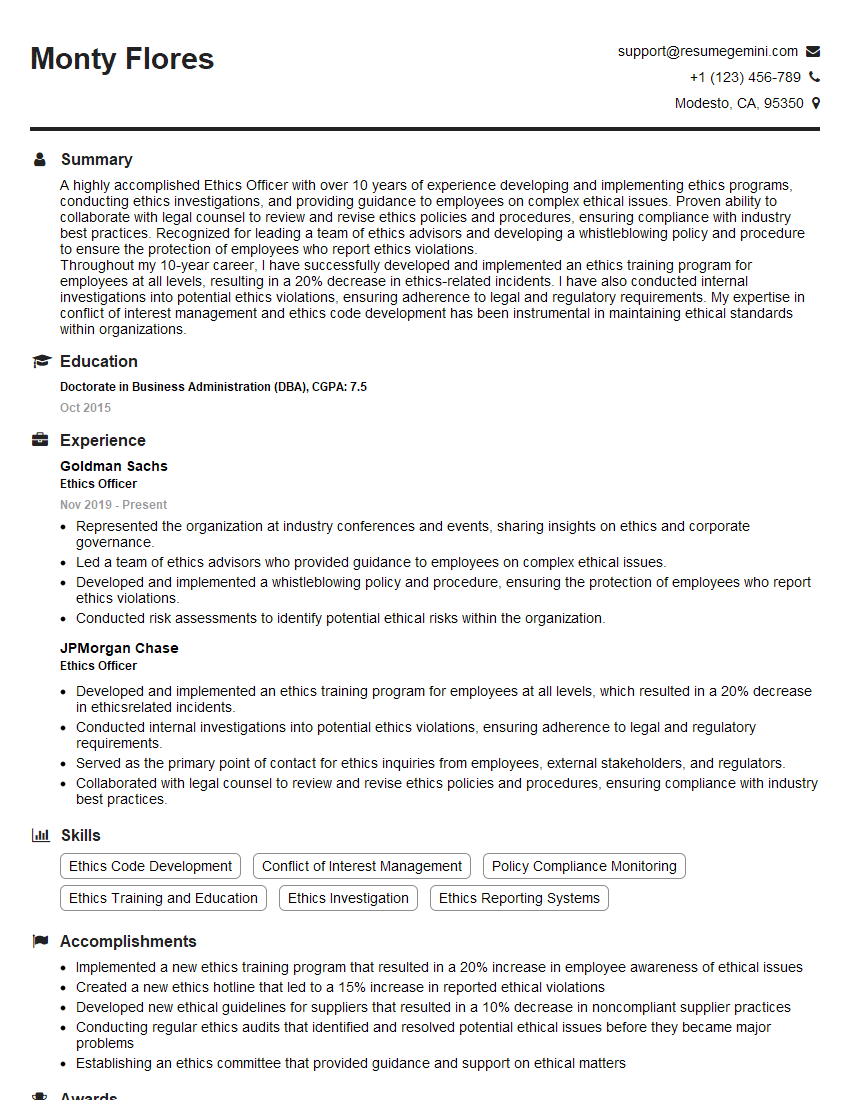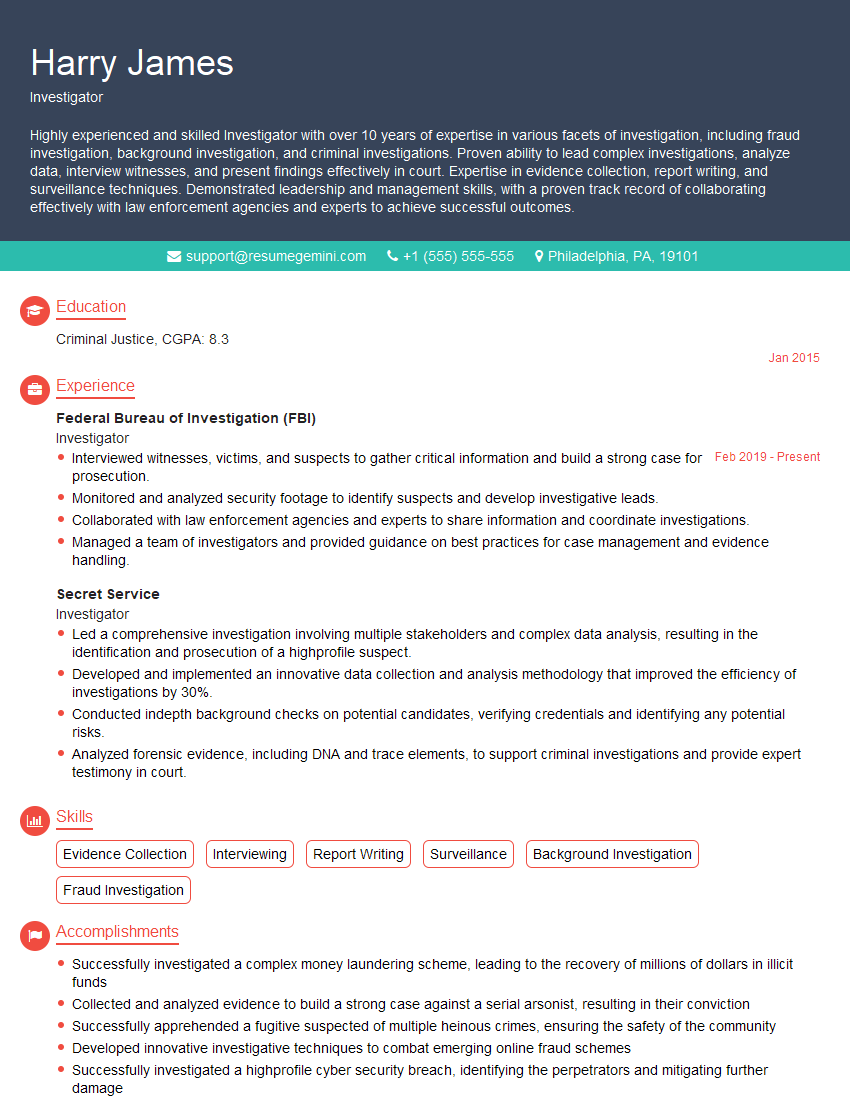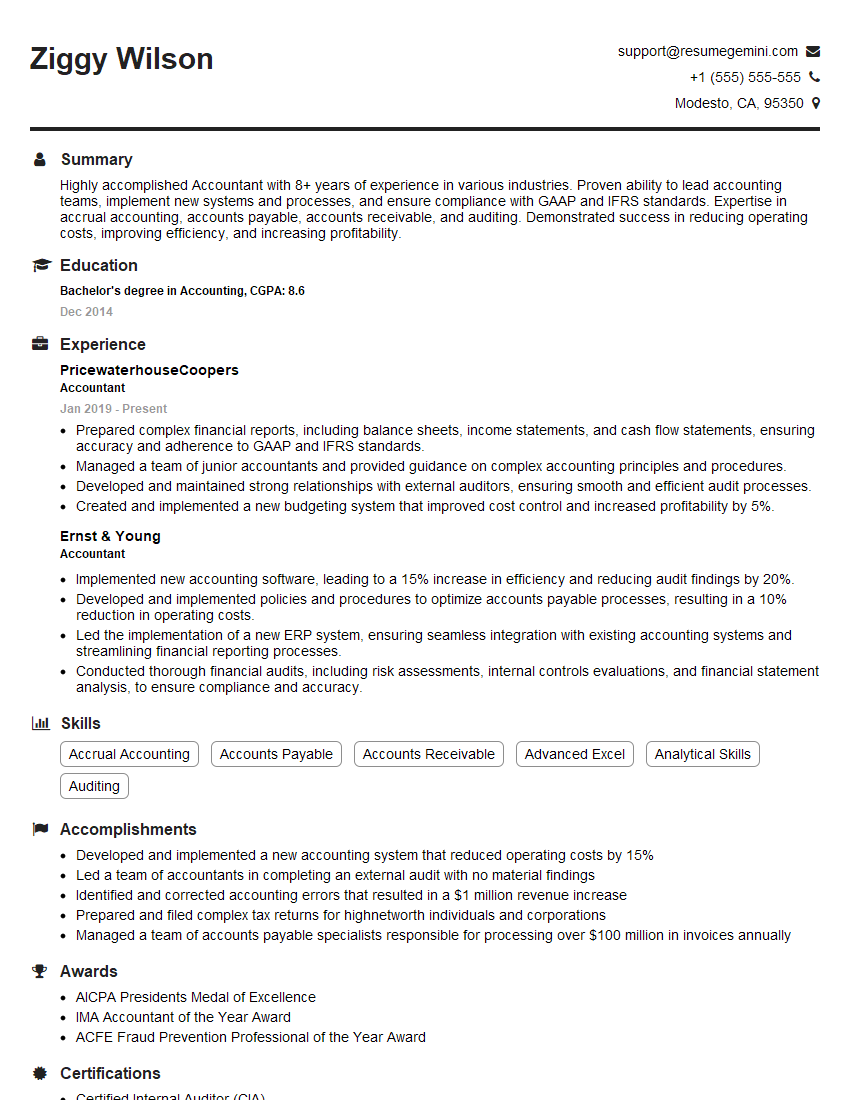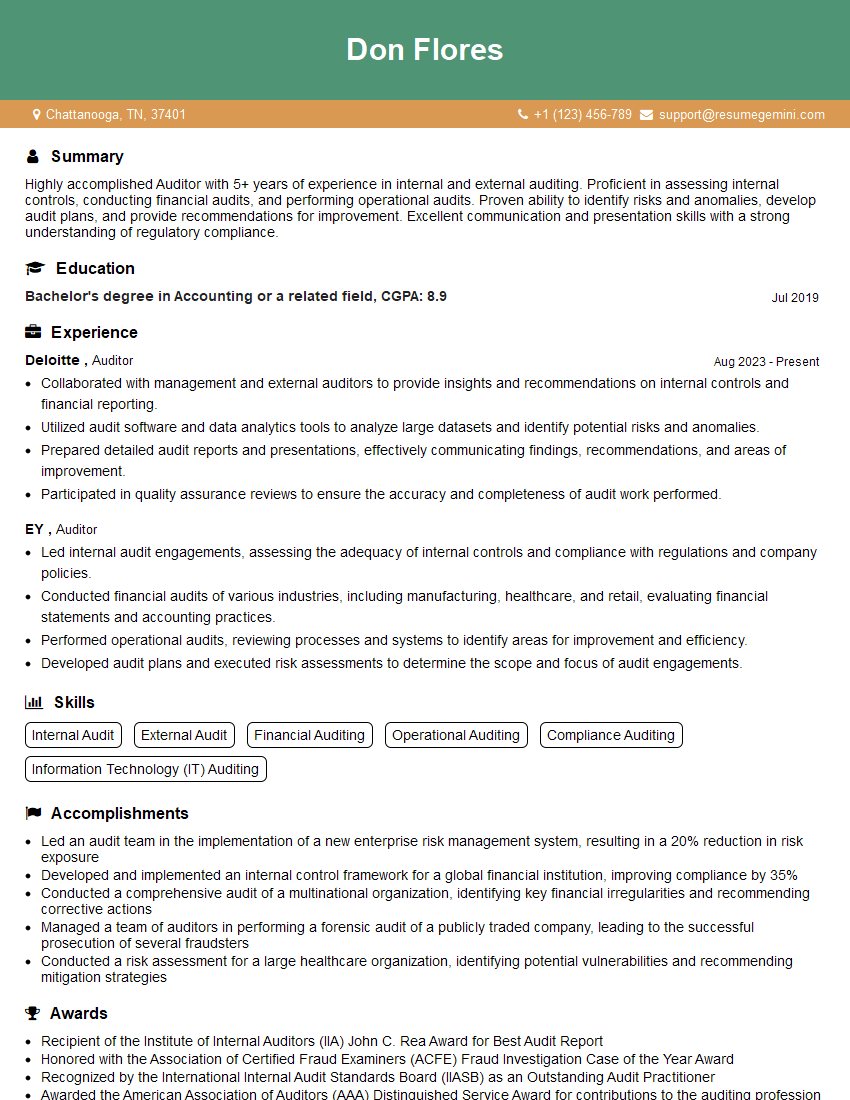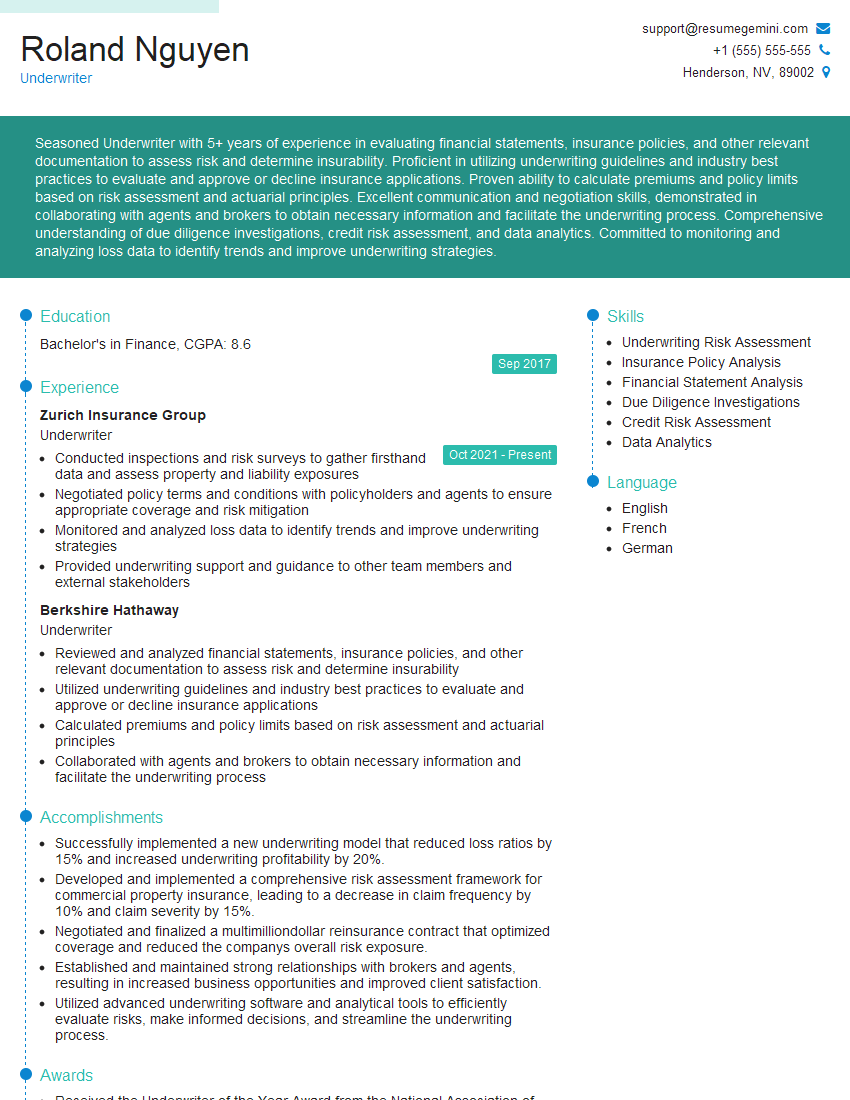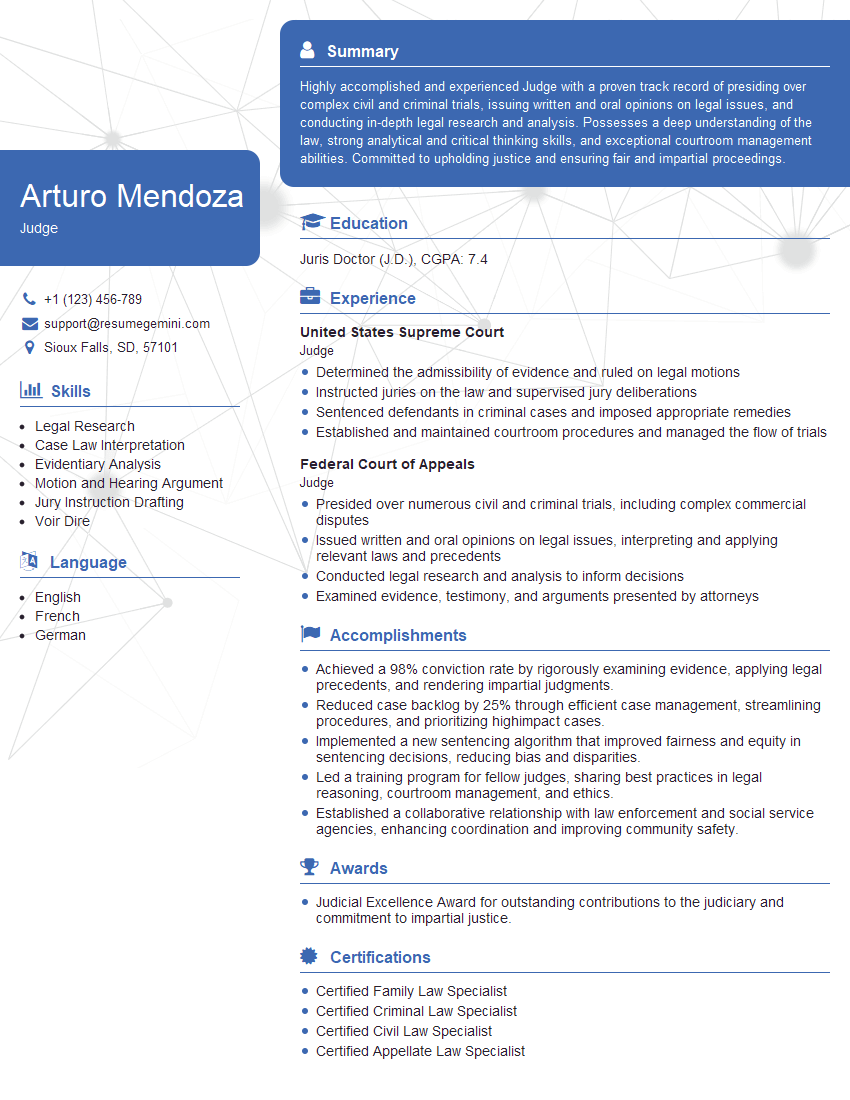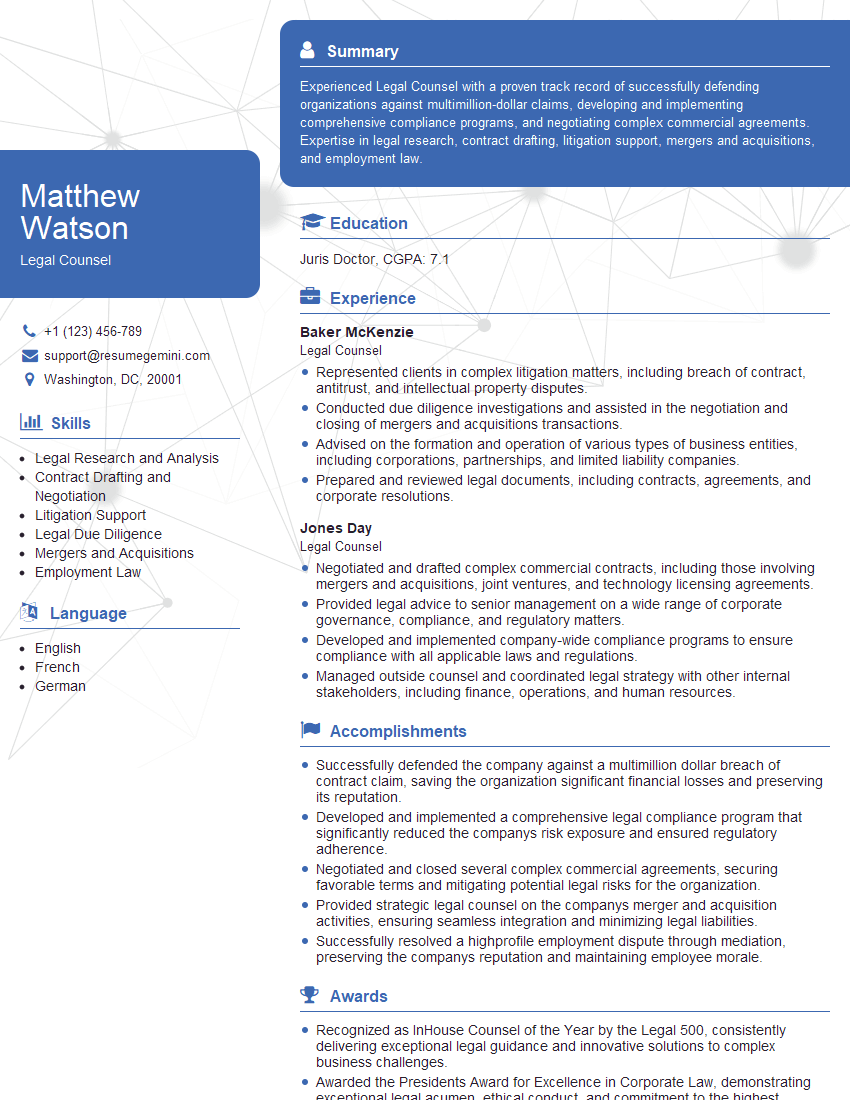Unlock your full potential by mastering the most common Integrity and Objectivity interview questions. This blog offers a deep dive into the critical topics, ensuring you’re not only prepared to answer but to excel. With these insights, you’ll approach your interview with clarity and confidence.
Questions Asked in Integrity and Objectivity Interview
Q 1. Describe a situation where you had to make a difficult decision based on objective data, even if it contradicted your personal feelings.
Objectivity requires basing decisions on factual data rather than personal feelings. It can be challenging when emotions are involved, but maintaining integrity demands this separation.
In a previous role, I was tasked with evaluating the performance of team members for promotion. One individual, a close friend, consistently underperformed based on the objective metrics – project completion rates, client feedback, and adherence to deadlines. While I valued our friendship, the data clearly indicated they were not ready for advancement. My personal feelings were set aside, and I presented the objective data to the promotion committee, recommending against their promotion. This was difficult, but upholding the integrity of the process was paramount. The uncomfortable truth, supported by data, was the foundation of my decision.
Q 2. How do you ensure the accuracy and completeness of your work, maintaining objectivity despite external pressures?
Accuracy and completeness are cornerstones of objective work. External pressures often try to compromise this; however, robust processes safeguard objectivity.
- Detailed Documentation: I meticulously document every step of my work, including data sources, methodologies, and assumptions. This provides a clear audit trail and minimizes the risk of errors or omissions.
- Cross-Verification: I independently verify data from multiple sources whenever possible. This helps to identify inconsistencies and ensures the accuracy of findings.
- Peer Review: I actively seek feedback from colleagues. A fresh perspective can often identify blind spots or biases I might have unintentionally introduced.
- Established Checklists and Protocols: Using standardized procedures ensures consistency and reduces the potential for human error, thereby strengthening objectivity.
For instance, if I’m analyzing market trends, I won’t rely on just one report. I’ll consult multiple reputable sources, compare their methodologies, and identify potential biases before drawing conclusions. This multi-faceted approach minimizes the influence of external pressures and prioritizes accurate, complete findings.
Q 3. Explain a time you discovered unethical behavior. What actions did you take?
Ethical breaches require immediate attention. Addressing them requires careful consideration and adherence to established protocols.
During a previous audit, I discovered a colleague falsifying expense reports. This violated company policy and ethical standards. My first step was to document the evidence thoroughly and confidentially. I then reported the issue to my supervisor, following the company’s established whistleblower protocol. It was a difficult decision because of the personal relationship, but upholding integrity superseded personal comfort. The outcome was an internal investigation, leading to corrective actions. The situation highlighted the importance of clear ethical guidelines and a robust reporting mechanism.
Q 4. How do you handle disagreements with colleagues when objective data supports differing conclusions?
Disagreements based on objective data require respectful, data-driven dialogue. The goal is not to ‘win’ the argument but to reach a shared understanding.
- Data Transparency: Sharing all relevant data openly and honestly ensures all parties are working from the same information.
- Methodological Review: Examining each other’s methodologies can identify potential sources of discrepancy.
- Open Discussion: Facilitating a collaborative discussion, where everyone can articulate their interpretation of the data, fosters mutual understanding.
- Seeking Mediation: If a resolution cannot be reached internally, an objective third party might be needed to help interpret the data and facilitate consensus.
Imagine two analysts interpreting the same sales data. One focuses on year-over-year growth, while the other highlights seasonal fluctuations. By openly discussing their approaches and data interpretations, they can reach a more holistic understanding of the market trends.
Q 5. Describe your approach to resolving conflicts where personal biases might interfere with objectivity.
Personal biases can subtly distort objective analysis. Recognizing and mitigating these biases is crucial for fair and accurate decision-making.
- Self-Reflection: Actively consider personal biases and potential conflicts of interest. Awareness is the first step to mitigation.
- Structured Analysis: Utilizing frameworks and methodologies helps minimize subjective influence by focusing on the data itself.
- Blind Testing: When feasible, removing identifying information from the data can reduce unconscious biases related to specific individuals or groups.
- Seeking External Input: A fresh perspective from someone unaware of the context can highlight potential biases.
For example, in performance evaluations, consciously using a standardized rubric prevents favoritism towards particular individuals, promoting objectivity.
Q 6. How do you balance confidentiality with the need for transparency and ethical reporting?
Balancing confidentiality and transparency requires careful judgment. The guiding principle is ethical reporting that respects privacy while ensuring accountability.
Confidentiality is paramount when dealing with sensitive information, such as personnel matters or financial details. However, transparency is needed to ensure ethical conduct and responsible reporting. The key is to share only the information necessary to achieve the objective without compromising confidentiality. For example, in reporting financial irregularities, you might mention a pattern of inconsistencies without revealing specific individual transactions. Anonymization techniques, whenever possible, protect individual privacy while maintaining the integrity of the report.
Q 7. Provide an example where you had to prioritize objectivity over personal relationships or opinions.
Prioritizing objectivity over personal relationships can be challenging but necessary for maintaining integrity.
I once had to assess a project proposal submitted by a close friend. Their proposal, while innovative, lacked crucial details and feasibility assessments based on objective market research. While I wanted to support them, I knew that providing a favorable assessment would be unethical. I provided a detailed and objective evaluation, highlighting the shortcomings while acknowledging the innovative aspects. My priority was the project’s success and the company’s interests, not our personal relationship. The feedback, though initially difficult, ultimately helped my friend improve their proposal.
Q 8. How do you identify and mitigate personal biases in your decision-making process?
Identifying and mitigating personal biases is crucial for objective decision-making. It’s a continuous process, not a one-time fix. I use a multi-pronged approach:
- Self-Reflection: Regularly examining my own beliefs and assumptions is paramount. I ask myself: What are my inherent biases? How might they influence my judgment? This involves considering my upbringing, cultural background, and personal experiences.
- Seeking Diverse Perspectives: Actively soliciting input from individuals with different backgrounds and viewpoints helps challenge my own assumptions and provides a more holistic understanding of the issue. This includes actively seeking out dissenting opinions.
- Structured Decision-Making Frameworks: Employing frameworks like cost-benefit analysis or decision matrices forces me to systematically evaluate all relevant factors, reducing the impact of unconscious biases. This provides a more data-driven approach.
- Blind Review Processes: When feasible, anonymizing information before review removes identifying details that could trigger unconscious biases. This is particularly useful in evaluating applications or performance reviews.
- Continuous Learning: Staying informed about cognitive biases and actively working to improve my awareness of them is ongoing. I regularly read research on decision-making and participate in training programs focused on bias mitigation.
For example, in a hiring process, I might intentionally seek diverse candidates and utilize blind resume reviews to mitigate potential biases against certain demographics.
Q 9. Explain a time you had to make a tough decision that prioritized integrity over immediate personal gain.
In a previous role, I was tasked with evaluating a new software vendor. One vendor offered a significantly more lucrative personal incentive – a substantial bonus for recommending their product. However, after a thorough evaluation, I discovered that another vendor’s product was superior in terms of functionality, long-term cost, and security. While the personal gain was tempting, I prioritized integrity and recommended the superior vendor, forgoing the substantial bonus. This decision, though difficult, strengthened my professional reputation and ultimately benefited my organization.
Q 10. How would you handle a situation where a superior asked you to compromise your integrity?
If a superior asked me to compromise my integrity, I would first attempt to understand their reasoning. However, if the request involved unethical or illegal behavior, I would politely but firmly refuse. My response would be guided by the following principles:
- Clearly state my ethical concerns: I would explain why the request is problematic, referencing relevant codes of conduct or company policies. This ensures a clear record of my position.
- Suggest alternative solutions: If possible, I would offer alternative approaches that achieve the desired outcome without compromising my integrity. This demonstrates a proactive and solution-oriented approach.
- Document the interaction: Thorough documentation of the conversation, including the date, time, individuals involved, and the details of the request and my response is crucial for protecting myself and maintaining a record.
- Escalate if necessary: If my concerns aren’t addressed, I would escalate the matter to a higher authority within the organization, or possibly an external ethics board or regulatory body if appropriate.
This approach prioritizes ethical behavior while attempting to find a constructive resolution within the organizational structure.
Q 11. Describe a time you faced a conflict of interest. How did you navigate the situation?
I once served on a committee evaluating grant proposals for a non-profit organization. My spouse worked for one of the organizations that submitted a proposal. To avoid any appearance or actual conflict of interest, I recused myself from the discussion and evaluation of that specific proposal. I informed the committee chair of my conflict and ensured that my absence would not compromise the fairness of the process. The transparency of my actions maintained my integrity and the integrity of the committee’s work.
Q 12. How do you ensure fairness and impartiality in your work, especially when dealing with sensitive information?
Ensuring fairness and impartiality when handling sensitive information requires a rigorous approach. This includes:
- Strict adherence to confidentiality protocols: This involves following all relevant policies and regulations governing the handling of sensitive data. This includes understanding data privacy laws like GDPR or HIPAA.
- Impartial data analysis: When reviewing or analyzing information, I strive to avoid any preconceived notions or biases. I focus on the facts and evidence presented, regardless of personal feelings or opinions.
- Equal application of rules and policies: I ensure that all individuals or entities are treated equally and fairly, without favoritism or discrimination. Consistency in application is key.
- Seeking external review if necessary: In complex cases, seeking an independent review from a neutral third party can ensure objectivity and transparency.
- Maintaining detailed records: Meticulous documentation of processes and decisions makes everything transparent and easily auditable, minimizing the potential for accusations of bias.
Q 13. How do you document your findings and decisions to maintain transparency and accountability?
Maintaining transparency and accountability requires detailed documentation. My methods include:
- Comprehensive notes and reports: Detailed notes on meetings, decisions, and findings ensure a clear record of the process. These notes include dates, times, attendees, decisions made, and rationales for those decisions.
- Version control for documents: Using version control (like Git) allows for tracking changes and providing an audit trail for important documents. This ensures the integrity of the documents.
- Secure data storage: Sensitive data is stored securely, following established protocols to protect confidentiality and prevent unauthorized access.
- Clear communication trails: Emails, meeting minutes, and formal reports are used to maintain clear communication trails and document all key decisions and interactions.
- Auditable systems: Where applicable, using auditable systems and software allows for easy tracking of actions and data access.
This rigorous documentation process ensures accountability and allows for easy review and analysis of decisions.
Q 14. How do you evaluate the credibility of sources of information when making objective assessments?
Evaluating source credibility is fundamental to objective assessments. My approach considers various factors:
- Source Expertise: Is the source an expert in the relevant field? What are their qualifications and credentials?
- Source Bias: Does the source have any potential biases that might influence their information? Consider funding sources, affiliations, and potential conflicts of interest.
- Evidence and Methodology: What evidence supports the information presented? Is the methodology rigorous and transparent? Are sources cited?
- Consistency and Corroboration: Does the information align with other credible sources? If not, why not? Inconsistencies should be investigated.
- Date of Publication/Update: Is the information current and up-to-date? Out-of-date information may be irrelevant or inaccurate.
- Reputation and Track Record: What is the reputation of the source? Has the source been known to provide accurate information in the past?
I often employ a process of triangulation, comparing information from multiple independent sources to ensure accuracy and mitigate the risk of bias.
Q 15. Describe a time you identified an error or oversight in your own work. What steps did you take?
Maintaining integrity involves acknowledging and correcting errors. In a recent project analyzing market trends, I mistakenly used outdated data in one of my key calculations. This oversight led to a flawed conclusion in my initial report.
- Identification: I discovered the error during a peer review when a colleague pointed out inconsistencies between my findings and their independent analysis. This highlighted the importance of thorough cross-checking and data validation.
- Correction: I immediately reviewed my data sources, identified the outdated file, and recalculated the results using the correct information. This required revising several sections of my report.
- Communication: I promptly notified my supervisor and team members of the error and explained the steps I took to correct it. Transparency was crucial in maintaining trust and credibility.
- Prevention: I implemented stricter data version control measures to prevent similar occurrences in the future. This included establishing clearer procedures for data updates and utilizing more robust data validation tools.
This experience reinforced the importance of meticulousness and the value of collaborative review in ensuring data integrity.
Career Expert Tips:
- Ace those interviews! Prepare effectively by reviewing the Top 50 Most Common Interview Questions on ResumeGemini.
- Navigate your job search with confidence! Explore a wide range of Career Tips on ResumeGemini. Learn about common challenges and recommendations to overcome them.
- Craft the perfect resume! Master the Art of Resume Writing with ResumeGemini’s guide. Showcase your unique qualifications and achievements effectively.
- Don’t miss out on holiday savings! Build your dream resume with ResumeGemini’s ATS optimized templates.
Q 16. How do you stay updated on industry best practices related to integrity and ethical conduct?
Staying current with best practices in integrity and ethical conduct requires a multifaceted approach. It’s not a one-time effort but an ongoing commitment.
- Professional Organizations: I actively participate in professional organizations like the [Insert relevant professional organization name], which offers continuous learning resources, webinars, and conferences focusing on ethical dilemmas and best practices in my field.
- Industry Publications: I regularly read reputable industry journals, magazines, and online publications that discuss ethical frameworks, case studies, and evolving regulations. This keeps me abreast of emerging challenges and innovative solutions.
- Continuing Education: I pursue relevant continuing education courses and workshops to strengthen my knowledge of ethical principles and legal requirements. These courses often feature expert insights and real-world scenarios.
- Networking: Engaging with colleagues and experts in my field through networking events and discussions provides valuable insights into ethical challenges they’ve encountered and how they resolved them.
By consistently engaging in these activities, I ensure that my understanding of ethics remains sharp and applicable to the current professional landscape.
Q 17. How do you handle situations where you are unsure of the ethical implications of a decision?
When faced with an ethically ambiguous situation, I follow a structured approach to ensure a responsible and well-informed decision.
- Identify the Ethical Dilemma: Clearly define the situation and the specific ethical issues involved. What are the potential consequences of each possible course of action?
- Consult Relevant Resources: Refer to the relevant ethical codes, legal guidelines, company policies, and professional standards to understand existing frameworks.
- Seek Advice: Discuss the dilemma with trusted colleagues, mentors, or ethical advisors. Gaining different perspectives can provide valuable insights and help identify blind spots.
- Consider Stakeholders: Evaluate how each potential decision might impact all involved parties. Who benefits? Who is potentially harmed?
- Document the Decision-Making Process: Keep a record of the dilemma, the steps taken to resolve it, and the final decision, along with the rationale. This is important for transparency and accountability.
Sometimes, when the situation is particularly complex or the potential consequences are severe, seeking legal counsel is appropriate.
Q 18. Describe your understanding of the ethical codes and regulations relevant to your field.
My field [Insert your field] adheres to [Insert relevant ethical codes and regulations, e.g., the AICPA Code of Professional Conduct for accounting professionals]. These codes outline fundamental principles like integrity, objectivity, confidentiality, and professional competence.
These regulations are not merely suggestions; they provide a framework for ethical decision-making and professional conduct. Non-compliance can result in serious repercussions, including professional sanctions, legal action, and reputational damage. A deep understanding of these codes and regulations is essential for ensuring ethical practice and building trust with clients and stakeholders.
For example, maintaining confidentiality is paramount. This means protecting sensitive information acquired through my work and ensuring it is not disclosed to unauthorized individuals or used for personal gain.
Q 19. How do you ensure that your decisions are not influenced by personal emotions or external pressures?
Objectivity is crucial in decision-making. Emotions and external pressures can significantly cloud judgment. To mitigate these influences, I employ several strategies:
- Self-Awareness: I actively recognize my own biases and emotions. This self-reflection helps me identify potential areas where my objectivity might be compromised.
- Structured Decision-Making Processes: I utilize frameworks like cost-benefit analysis or decision matrices to make decisions based on quantifiable factors rather than subjective feelings.
- Seeking External Perspectives: I actively solicit feedback from colleagues who can offer an unbiased assessment of the situation. This provides checks and balances against personal biases.
- Ethical Frameworks: I deliberately apply ethical frameworks and principles to guide my decision-making, providing a structured approach that prioritizes fairness and objectivity.
By systematically addressing potential sources of bias and employing objective decision-making tools, I strive to ensure fairness and impartiality in my work.
Q 20. Explain a time when you had to defend an unpopular decision based on objective facts and data.
In a previous role, I had to defend a decision to discontinue a product line that was not financially viable despite some team members’ objections. Although the product had emotional ties for some employees (it had been around for a long time) and was popular among some customer segments, objective data clearly indicated consistent losses.
My defense relied on:
- Financial Data: I presented detailed financial reports showcasing the continuous losses associated with the product line. This included revenue figures, manufacturing costs, and marketing expenses.
- Market Analysis: I presented market research indicating a declining demand for this product and the emergence of superior alternatives.
- Strategic Alignment: I explained how discontinuing the product aligned with the company’s overall strategic goals of focusing on profitable and sustainable ventures.
While the decision was initially met with resistance, I successfully demonstrated that my decision was based on objective facts and sound business judgment, leading to acceptance and eventual understanding.
Q 21. How do you identify and address potential conflicts of interest in your team or organization?
Identifying and addressing potential conflicts of interest is critical for maintaining the integrity of any team or organization. This is a proactive process, not reactive.
- Conflict of Interest Policy: A clearly defined policy that outlines what constitutes a conflict of interest and provides guidelines on disclosure and mitigation strategies is crucial.
- Regular Training: Regular training sessions for all team members to raise awareness of potential conflicts and the importance of disclosure are essential.
- Disclosure Mechanisms: Establish clear processes for employees to disclose potential conflicts, ensuring they feel comfortable reporting without fear of retribution.
- Review and Monitoring: Regularly review projects and activities to identify potential conflicts. This might involve analyzing financial transactions, consulting contracts, or reviewing relationships between employees and external parties.
- Mitigation Strategies: Develop clear procedures for addressing and mitigating identified conflicts. This could include recusal from decisions, seeking external oversight, or establishing independent review processes.
A culture of transparency and accountability is essential for effectively managing potential conflicts of interest.
Q 22. How do you handle confidential information to maintain trust and uphold ethical standards?
Maintaining confidentiality is paramount to building and preserving trust. It’s not just about following rules; it’s about understanding the ethical implications of disclosing sensitive information. My approach is multi-faceted:
- Strict adherence to data protection policies: I meticulously follow all company policies and relevant regulations (like GDPR, HIPAA, etc.) regarding data handling and access control. This includes understanding access permissions and ensuring I only access information necessary for my role.
- Secure data storage and transmission: I utilize secure systems for storing and transmitting confidential information, employing encryption and password protection where appropriate. I avoid storing sensitive data on personal devices.
- Need-to-know basis: I only share confidential information with those who have a legitimate need to know and who are bound by the same confidentiality agreements.
- Regular security awareness training: I actively participate in and stay updated on security awareness training to remain informed about the latest threats and best practices.
For example, in a previous role involving client financial data, I strictly adhered to access protocols and never discussed sensitive information outside of secure channels, even with colleagues who weren’t directly involved in the project. My commitment to confidentiality fostered strong trust with clients and maintained the integrity of the firm.
Q 23. How do you approach fact-checking and ensuring the accuracy of information before making a judgment?
Fact-checking is the cornerstone of objective judgment. It’s a systematic process I approach with rigor and skepticism, even when dealing with information from trusted sources. My approach involves:
- Identifying the source: I assess the credibility and potential biases of the source. Is it a reputable organization? Does the source have a history of accuracy? What is their motivation for sharing this information?
- Cross-referencing information: I consult multiple independent sources to corroborate the information. This helps identify inconsistencies and potential inaccuracies.
- Evaluating evidence: I look for evidence supporting the claims, evaluating the quality and relevance of that evidence. This often includes checking methodologies, sample sizes, and potential confounding factors if statistical data is presented.
- Considering alternative explanations: I actively seek out alternative interpretations or explanations for the information presented, considering any potential counterarguments.
- Recognizing limitations: I acknowledge that complete certainty is often impossible. My assessment always considers the limitations of the available evidence and potential uncertainties.
For instance, if reviewing a research paper, I would not only read the abstract and conclusions, but delve into the methodology section to validate its rigor and analyze any potential flaws or biases. This thorough approach allows for a more accurate and nuanced understanding of the information before forming a judgment.
Q 24. Describe a situation where your objectivity was challenged. How did you respond?
In a previous project, a colleague strongly advocated for a solution that, while seemingly efficient, lacked ethical considerations regarding data privacy. My objectivity was challenged because the solution was championed by a senior member of the team, and I feared potential repercussions for disagreeing. However, I:
- Maintained a calm and respectful demeanor: I listened to my colleague’s arguments, demonstrating I valued their perspective.
- Presented a counterargument based on facts: I highlighted the data privacy concerns and potential legal ramifications, referencing specific regulations and precedents.
- Offered alternative solutions: I proposed alternative solutions that addressed both efficiency and ethical concerns.
- Documented everything: I kept detailed records of the discussion, my concerns, and the proposed solutions.
Ultimately, my presentation of evidence and reasoned arguments led to a revised approach that prioritized both efficiency and ethical compliance. This reinforced the importance of objectively weighing all factors, even when facing pressure from senior team members. The project’s success, despite the initial conflict, highlighted the value of maintaining integrity and objectivity.
Q 25. How do you foster a culture of integrity and ethical conduct within your team or organization?
Cultivating a culture of integrity and ethical conduct requires a multi-pronged approach, focusing on leadership, communication, and accountability:
- Lead by example: Leaders must embody the values they expect from their teams. This includes transparent communication, ethical decision-making, and a commitment to fairness and accountability.
- Establish a clear code of conduct: A well-defined code of conduct, understood and readily accessible by all team members, sets expectations and provides guidance on ethical dilemmas.
- Provide ethics training: Regular ethics training, incorporating real-world scenarios and case studies, helps develop ethical reasoning skills and equips employees to navigate challenging situations.
- Create a safe space for reporting: Establish clear and accessible mechanisms for reporting ethical violations, ensuring confidentiality and protection from retaliation.
- Foster open communication: Encourage open dialogue and feedback, allowing employees to raise concerns without fear of retribution.
- Regularly review and update policies: Ethical standards and best practices evolve, necessitating regular reviews and updates to the code of conduct and internal policies.
For instance, I’ve implemented a system of regular ethics discussions in team meetings, prompting scenarios and encouraging open conversations about ethical challenges and effective solutions. This fosters a proactive approach to ethical conduct and makes it part of the everyday work culture, rather than a separate topic.
Q 26. How do you ensure transparency in your communications and decision-making processes?
Transparency in communication and decision-making builds trust and fosters collaboration. My approach involves:
- Clear and concise communication: I ensure my communications are easily understood, avoiding jargon and technical terms where possible. I actively seek feedback to clarify any misunderstandings.
- Open access to information: I provide access to relevant information to stakeholders, ensuring they have the context necessary to understand decisions.
- Explain reasoning behind decisions: I clearly explain the rationale behind my decisions, outlining the factors considered and the process followed. This helps ensure buy-in and avoids any perception of arbitrary or unfair actions.
- Regular updates: I keep stakeholders informed of progress and any significant changes, providing regular updates through appropriate channels.
- Proactive disclosure of potential conflicts of interest: I proactively disclose any potential conflicts of interest, ensuring that decisions are not influenced by personal biases.
For example, when managing a project, I regularly share progress reports, highlight challenges and mitigation strategies, and solicit feedback through team meetings and open forums. This proactive communication minimizes misunderstandings and builds trust among stakeholders.
Q 27. How do you handle pressure from stakeholders to compromise on ethical standards?
Pressure to compromise ethical standards is a common challenge. My response is firmly rooted in maintaining my ethical compass:
- Clearly state my position: I firmly but respectfully communicate my concerns and explain why compromising ethical standards is unacceptable. I emphasize the potential consequences, both professionally and legally.
- Propose alternative solutions: I explore alternative strategies that achieve the stakeholder’s goals without compromising ethical principles. This shows I’m committed to finding solutions, not just stating objections.
- Document interactions: I meticulously document all interactions, including emails, meeting minutes, and any formal requests to compromise ethical standards. This provides a record for future reference.
- Seek counsel: If the pressure persists, I consult with my supervisor, HR department, or legal counsel to determine the best course of action.
- Escalate if necessary: In extreme cases where ethical violations are imminent, I will escalate the issue to the appropriate authorities, even if it means potential personal risk.
I view this as a responsibility, not a burden. Maintaining integrity outweighs any short-term pressure. In the long run, adherence to ethical principles builds trust and fosters a more sustainable and successful environment.
Q 28. Describe a time you had to make a difficult decision related to ethical dilemmas in a professional setting.
In a previous role, I faced a dilemma involving a project that was behind schedule and over budget. The project manager suggested cutting corners to meet the deadline, which would have involved compromising data security protocols. This directly violated company policy and jeopardized client confidentiality.
After careful consideration and consultation with my supervisor, I decided to:
- Report the issue: I immediately reported the project manager’s suggestion to my supervisor, detailing the potential ethical and legal implications.
- Propose a revised plan: I worked with my supervisor and the team to develop a revised project plan that prioritized data security and ethical compliance, even if it meant extending the deadline.
- Communicated transparently with stakeholders: We informed all stakeholders of the situation and the revised plan, explaining the rationale behind the delay. While this resulted in temporary inconvenience, the transparency maintained trust and mitigated potential negative consequences.
While the decision resulted in a delay, it prevented a much more serious breach of trust and potential legal repercussions. This experience reinforced my conviction that integrity and ethical compliance are non-negotiable, even under immense pressure. The long-term positive impact of maintaining ethical standards significantly outweighed the short-term inconvenience.
Key Topics to Learn for Integrity and Objectivity Interview
- Defining Integrity: Understanding the principles of honesty, ethical conduct, and moral responsibility in professional contexts. Explore how personal values translate into workplace actions.
- Practical Application of Integrity: Discuss situations where you’ve faced ethical dilemmas and how you navigated them, emphasizing your decision-making process and adherence to ethical guidelines. Prepare examples showcasing your commitment to fairness and transparency.
- Objectivity in Decision-Making: Analyze how to approach situations impartially, considering all relevant facts and avoiding personal biases. Practice structuring your responses to demonstrate your ability to separate emotions from objective analysis.
- Demonstrating Objectivity: Prepare examples showcasing your ability to provide constructive criticism, offer balanced perspectives, and make data-driven decisions, even when faced with challenging situations or conflicting opinions.
- Integrity in Teamwork: Discuss your approach to collaborating with colleagues, highlighting instances where you’ve upheld ethical standards within a team environment. Consider scenarios involving conflict resolution and maintaining professional conduct.
- Maintaining Confidentiality: Explain your understanding of confidentiality protocols and your experience in handling sensitive information responsibly. Be prepared to discuss situations where you’ve maintained the privacy of data or information.
- Recognizing and Addressing Bias: Explore methods for identifying potential biases in data analysis, decision-making processes, and interpersonal interactions. Practice articulating how you actively mitigate the impact of personal biases.
Next Steps
Mastering integrity and objectivity is crucial for career advancement. Employers highly value individuals who demonstrate unwavering ethical standards and the ability to make impartial judgments. This builds trust, fosters strong working relationships, and contributes to a positive and productive work environment. To significantly boost your job prospects, create an ATS-friendly resume that effectively showcases these qualities. ResumeGemini is a trusted resource that can help you build a professional resume highlighting your strengths in integrity and objectivity. Examples of resumes tailored to these key attributes are available to help guide your process.
Explore more articles
Users Rating of Our Blogs
Share Your Experience
We value your feedback! Please rate our content and share your thoughts (optional).
What Readers Say About Our Blog
This was kind of a unique content I found around the specialized skills. Very helpful questions and good detailed answers.
Very Helpful blog, thank you Interviewgemini team.





